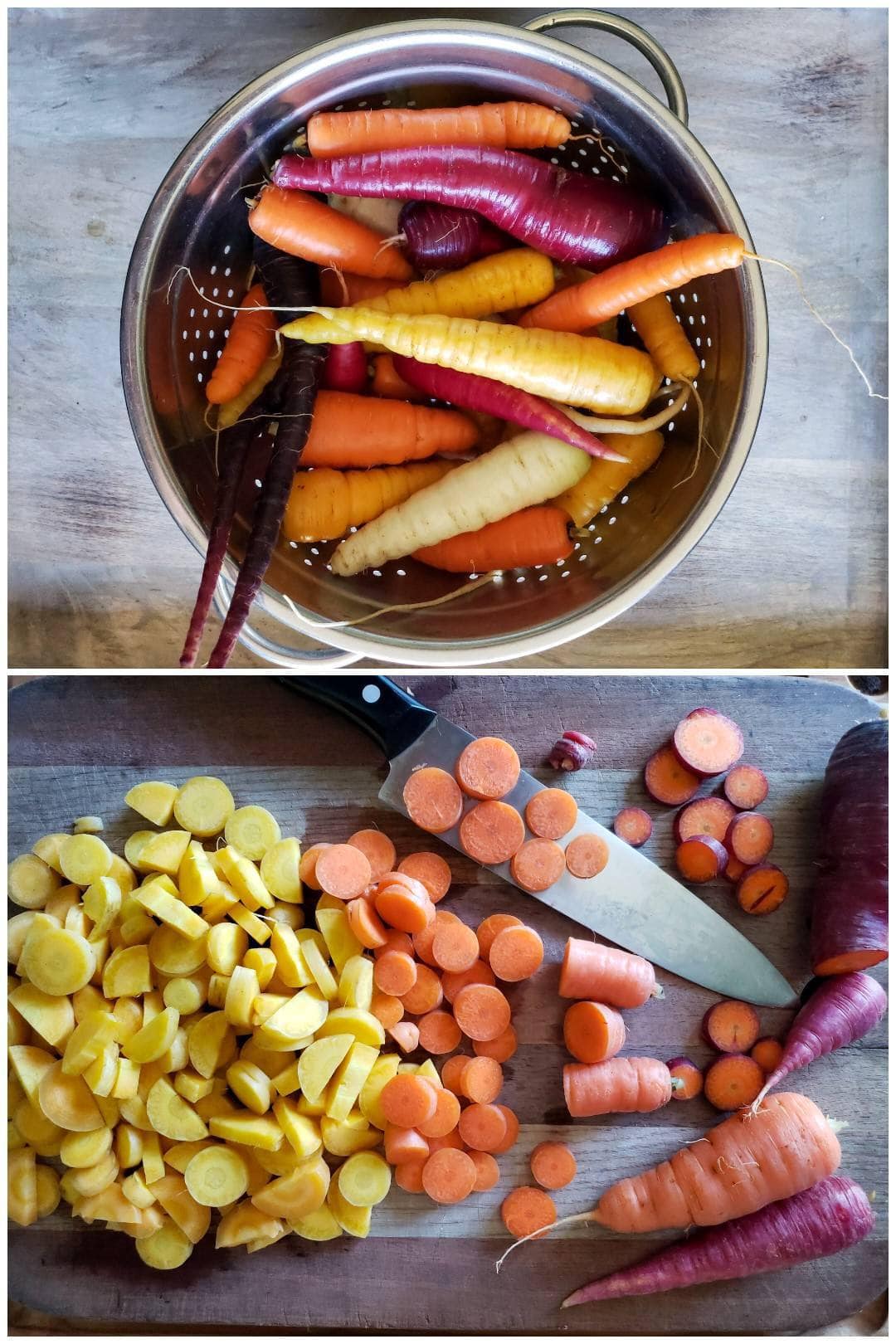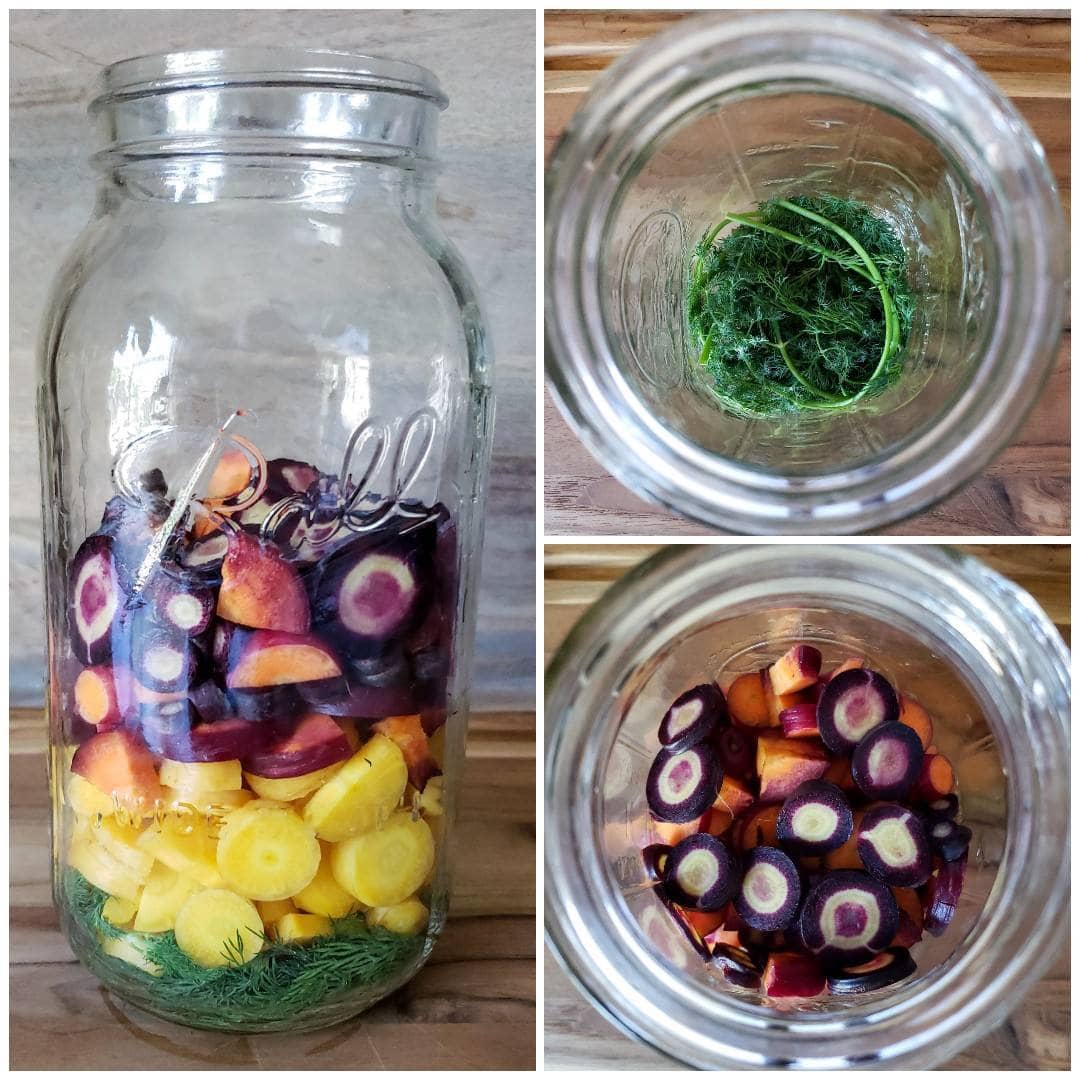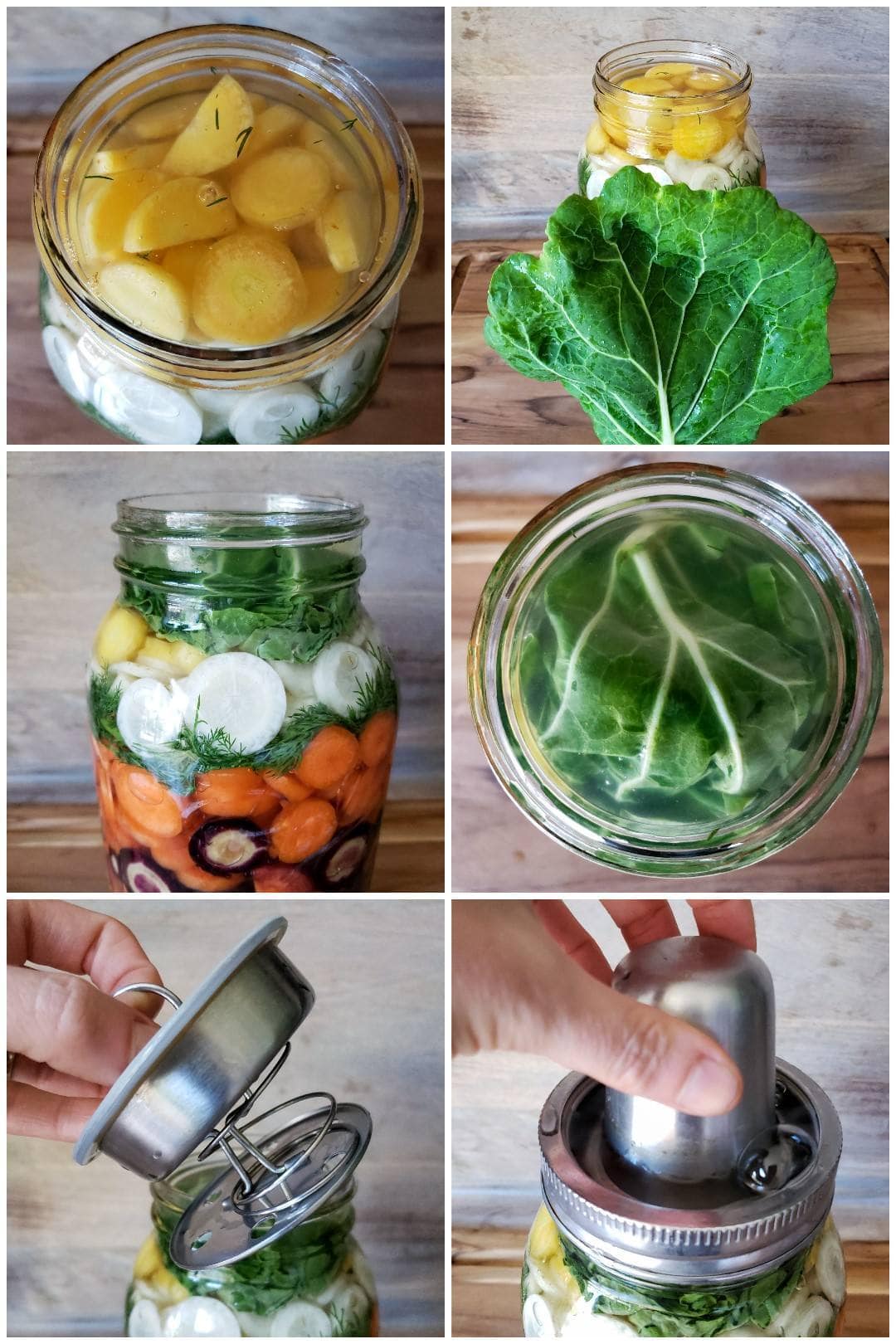Home»Food & Ferment»Ferment»Fermented Foods
Last Updated on September 21 , 2023
It is no secret that we love fermented foods around this homestead . Fermented food are delightful , and theyimprove gut wellness , inflaming , digestion , overall exemption , and more . Fermented carrots are no different . tempestuousness is also an excellent way to preserve food when you have a large harvest time or abundance on your hands . Like now , after we just reap over 20 pounds of carrots from the garden !

Would you like to save this?
We ’ll netmail this situation to you , so you’re able to fare back to it after !
I agree to invite e-mail updates .
Even if you do n’t have homegrown carrot to use for this fermented carrot recipe , I extremely paint a picture impart it a go anyways ! Pick up a bunch of Daucus carota sativa from your farmer ’s marketplace or local grocery store . But recall , it is always better tochoose organic producefor ferment recipes . Inorganic produce can intervene with a safe fermentation outgrowth , and also give rise off - flavors .

Ingredients and Supplies
Instructions
1) Clean your supplies
You want to verify all of your supplies are clean . No , they do n’t demand to be insanely clean or “ uninspired ” . You actuallynever want to employ bleach ( or even soap ) on your fermenting tools!The residual could cling around and really make thing taste “ off ” . We spray ours withplain white acetum , and then rinse well with hot water . That ’s it . I do the same with my hand .
2) Prep the carrots
If they ’re still attached , remove the carrot park . you could use up those greens you know ! Towards the end of our“how to grow carrots ” C. W. Post , check out five melodic theme for how to use Daucus carota sativa greens ! Or , at least try tocompostthem .
Wash the carrot well . Like the other supplies , the carrots do n’t need to be unhinged sterile - fair . avert using goop or produce washes .
Cut the carrots into the physical body and size of it of your liking . We often choose to cut ours intosmall bite - size turn slices , about 1/8 – 1/4 inch dense . This is because we normally eat our ferment carrot on top of salads or other meals . If you hope to snack on your ferment carrot more like pickles , you could cut them intocarrot stick spearsinstead . They ’ll sour well all the same !

3) Add seasonings of choice
In the bottom of your chosen fermenting vessel , contribute somefreshly washed sprigs of dill . I propose this simple “ seasoning ” at lower limit . As long as you do n’t dislike dill , it provides a very balmy and delicious addition ! The amount of dill does n’t need to be precise . If you get the smaller charge plate clamshell packages , I ’d say use one-half for a quart jar , and the whole thing for a half - congius jar . If you ’re capable to get a larger , lax clustering of dill , we mostly utilize about a quartern of those per quart jar , and half a large bunch per half - gallon jar .
We also often times add up a couple Eugenia aromaticum of freshgarlicat the bottom of the jar . ( We hap to be out when we made this batch ) . If you do n’t like dill or garlic , you could totally skip either and keep it crack simple ! Or if you loooove garlic , you may add more . Personally , we have constitute that ferment garlic can overtake the tang of everything else if you go too heavy . We witness about 1 - 2 clove tree of ail in a quart jar , and 3 - 4 cloves perhalf - gallon jaris our angelical spot .
you could alsoget creativehere and go beyond what this basic recipe is calling for . For example , sum a mite of peppercorns , a sprinkle of celery seed or leaf mustard seeds , a chunk of impertinent ginger or Curcuma longa , a dash of red chili flakes , or even a whole hot chilli pepper or two – if you want some heat ! That ’s the beauty of fermenting . The option for experimentation and creative thinking are dateless . Keep in mind that tang normally mellow out when ferment too . For example , hot chili pepper will becomemuchless spicy than when eaten raw or even cooked once they ’re fermented .

4) Pack the jar
part adding the cut Daucus carota sativa to the jar . When fermenting , it ’s good to try andfit as many veggies in the jaras possible . If you ’re move through this process , you might as well maximise the amount of genteel food you get out of it in the terminal ! This will also reduce the amount of brine needed , and the amount of air travel that can get trapped at bottom . So , when you ’re invest the carrot into the jarful , try not to just throw smattering in there all haphazardly .
We prove to layer them in small by little , packing them down as we go toreduce air pockets . I usually fulfill half the jar with the sliced veg , then add another picayune layer of dill and a clove of garlic about midway through , then carry on layer with more veggies until the jar is totally full . If you cut your carrot into sticks , attempt to stack and insert them tightly against one another too .
5) Make a brine
The received saltwater proportion for fermented vegetables is1 tablespoon ofsea saltor cosher salt per 2 cups filter water . Do not use veritable table salt or salt that has been otherwise iodized . It will say it on the packet if it has been . This messes with the agitation process , and does n’t sample as practiced .
The destination is to unfreeze the saltiness in the filtered water , so it will demand to be room temperature or more or less warmer . We make our saltwater in a dope on the stovetop , but on a very down heat – just until the common salt is able to dissolve – and then permit it cool down a spot . You do not want to bring red-hot seawater to your ferment , but ardent is okay . Too much heat will kill the good bacteria ( lactobacillus ) need to safely ferment your carrots !
We will usually get the saltwater going on the stove while we are prepping the carrots . This way of life , if it accidentally gravel a little too warm , it has time to cool down down before adding it . With a to the full - pack jar of veggies , we have found that2 cup of saltwater is equal per quart jar – threefold everything when usinghalf - gallon jolt .

6) Pour it in
Slowly stream the brine into the jarful , until the carrots are totally covered . sac of air are in all likelihood trap in there , so give the jar a little pat and wiggle to essay to get them to come up . you’re able to also use awooden kraut muller or tamperto constrict the Daucus carota sativa down and expel air .
7) Add a weight
Some of the carrots will endeavor to float to the surface , but they doneed to stay submerged below the saltwater level . If they ’re allow to float and be in contact with airwave , mold can develop!The stainless steel all - in - oneKraut Sourcefermentation lids we use have a monotonous plate and saltation inside that help to easily accomplish this , acting as a weight to keep everything down . Another option is to use a ceramic orglass weight made for fermenting . Some people get resourceful and habituate other clean items that equip inside their vessel , like a boil stone or littler spyglass jounce .
Even if you use a weight or Kraut Source gadget , sometimes bit of chopped carrot can still skid around them . To keep the floaters at bay , we often use alarge leaf of cabbage , collard green , or other hearty common to make a “ cap” . This is placed on top of the veggies , below the exercising weight , and retain them trapped below . It should also be submerged in the brine as much as possible . The Kraut Source gadget does a big job stay fresh floaters down in pint and quart sizing jars , but we usually add a “ gelt crownwork ” to the larger half - Imperial gallon batches .
8) Cover
Next , the jolt or container you ’re fermenting in need to be compensate with a mean meet lid . Theuse of an air - lock chamber lid made for zymolysis is preferred . These allow for the liberation of any excess air and carbon dioxide that is bring out during tempestuousness , without allowing Modern melody or anything else to come in . This is one reason why we really love theKraut Sourcelids ! They not only have a weight that keeps everything inundate , but also have a small moat on top that you fill with water , thus creating an air ringlet .
There are a lot of other mason jar fermentation lids out there too ! Here are somesilicone nipple character . These would need to be used in continuative with a free weight of some form , like these methamphetamine ones . If you ’re not using an atmosphere lock , you’re able to tightly screw on a even lid , but then verify to cursorily “ burp ” your jounce every few days to release the build up C dioxide .
9) Ferment!
Once it ’s all put together , rent your mixture sit down out atroom temperature for 7 - 14 daysto do its thang . The time depends on your personal flavor preference , and the temperature of your house . We get most of our ferment go for about 10 - 14 days .
Warmer conditions will cause the carrot to ferment more quickly , and cooler does just the opposite . The ideal ferment temperature is around70 - 75 degreesFahrenheit . If it is summertime time and your house is warmer than this , adjudicate to find a slightly cooler locating for your vas to attend out . Too spicy of conditions can advance the development of white Kahm yeast . It is not dangerous , but rather stinky and off - putt .
During fermentation , you will notice the fermented Daucus carota sativa start out to undergo alteration . The lactobacillus is working aside to convert the starches in the intellectual nourishment into lactic Zen , which preserves it . In the process , C dioxide is formed , so you ’ll in all likelihood see somebubbling activityin there !

The fermented carrots will also start out tochange color . bet on the color of the carrots you used , they made bleed and twist the saltwater color . Our sinister nebula carrot bled purpleness and turned the entire plenty bright pink . The saltwater also getscloudy , and this is entirely normal !
If you are using aKraut Sourcelid , keep an eye on its fiddling water - filled moat , making sure it always has some unclouded pee in there . It does n’t dry out easily though . On the other hand , our vessel usually well over from the lid for the first several days of fermentation . Be forewarned that yours may do the same ! So we alwayset the jars on a plate or in a bowl to capture the overflow . Once that initial burst of activeness subsides ( about 5 days later ) , the fosse can dry out up and you ’ll want to add more water into it .
Another thing you may notice during fermentation may be a slightly oddodor . This is totally normal ! To be honest , some fermentation can smellpretty farty . I promise they taste well than they smell !

10) Refrigerate
When the time is up , take the “ cabbage chapiter ” and melodic line - ignition lock eyelid , replace it with a regular lid , and move your finished fermented carrots to thefridge . Because of the acidity of ferment food , standard mason jar lids have the tendency to rust . To avoid this , we hive away our ferments with eitherthese untarnished steel lidsorthese BPA - detached plastic ones .
Most fermented foods aregood for several monthsin the fridge , if not long . We have enjoyed kraut about a twelvemonth after it was made – though we always eat it up faster than that !
11) Enjoy!
Now it is sentence to feed your belly with probiotic - rich domicile - fermented nutrient ! We have sex to use thesefermented carrots as a salad topping , or on top of sautéed veggies withcurry lentils . They could also be used chop up in orchis salad , on sandwiches , like a muddle on an hor d’oeuvre shell with cheese and crackers , or just snack on plain!Don’t contrive out that brineeither ! The liquid is also chock full of probiotics and beneficial enzymes , just waiting to make your belly happy . Did you bonk they in reality sell leftover ferment brine , market as“gut shots ” , at natural food store ? And they are n’t cheap ! We like to drizzle some on top of salad with olive vegetable oil as a dressing , or even take petty shots of it directly !
Now you’re off!
Go make some insanely healthy fermented carrots of your own . Do not be nervous!If you perform these actions , it is really quite difficult to “ mess up up ” . In all our years fermenting , we have NEVER had mildew form in a fermenting watercraft . for sure , we ’ve made some strange concoctions that we did n’t get it on as much as others , but we have certainly never made ourselves sick . Feel devoid to ask me any head !
If you like this recipe , you ’ll also love ourfermented dilly radish formula . It ’s fundamentally the same process , but with radishes rather of carrot ! queer to get wind turn foods are so great for your health?Check outthis postthat talks all about the health benefit of fermented nutrient !

